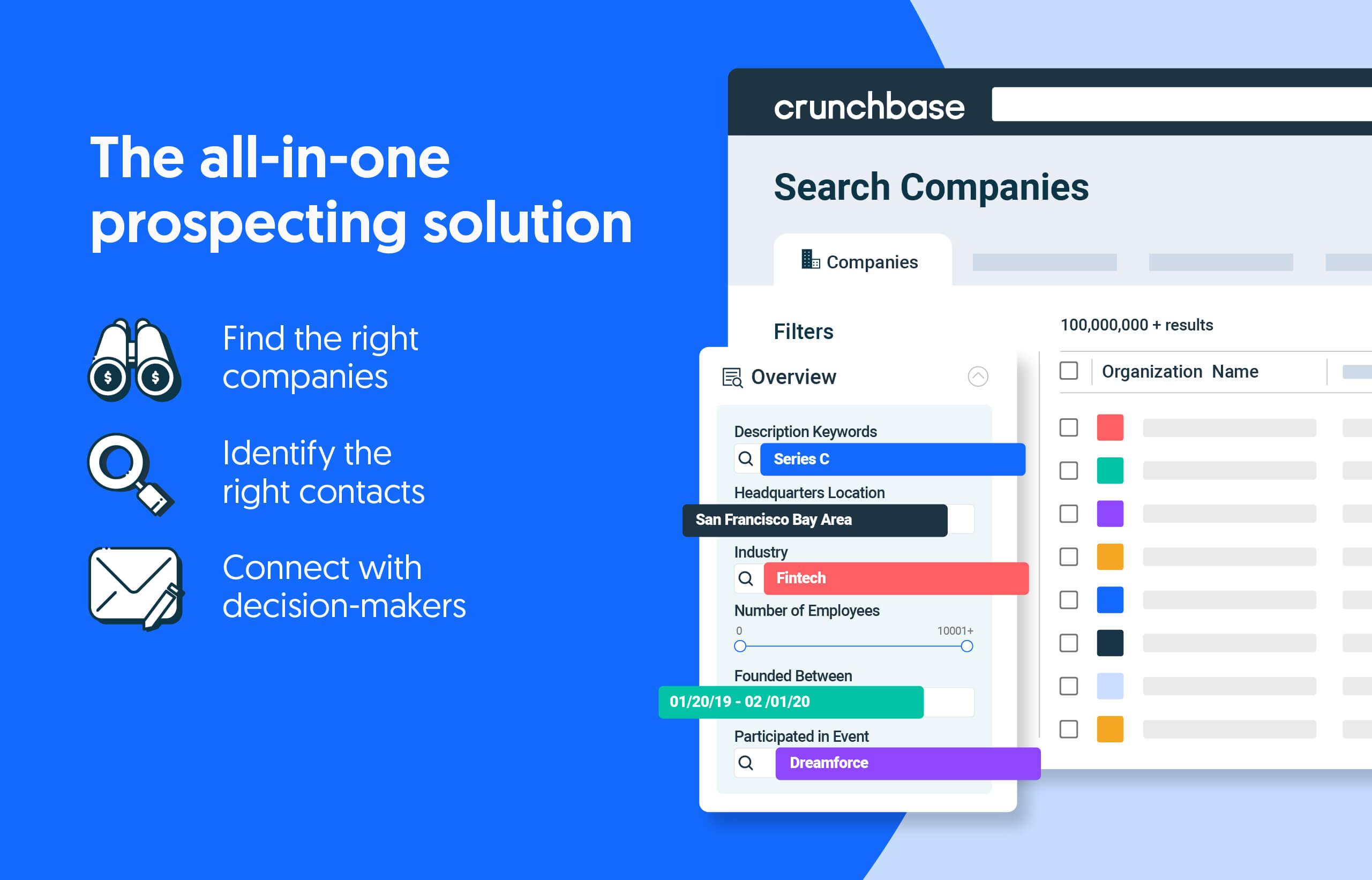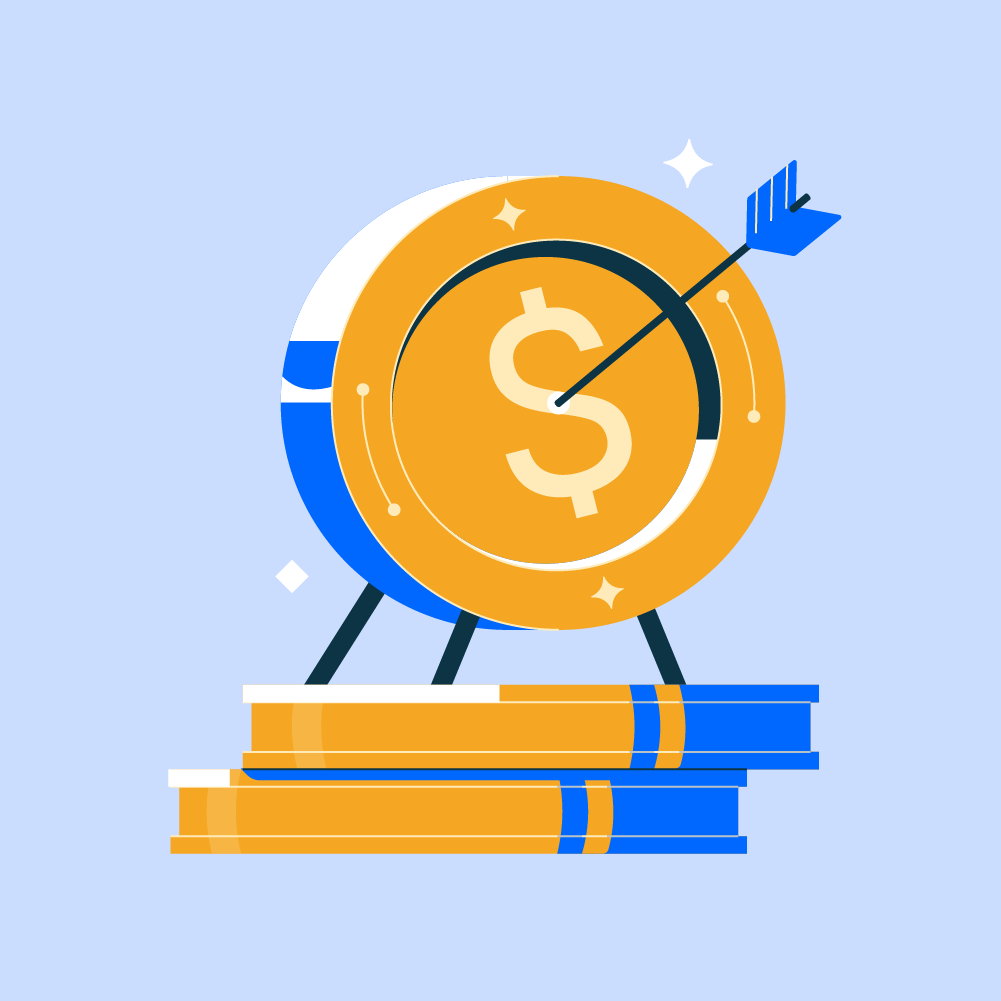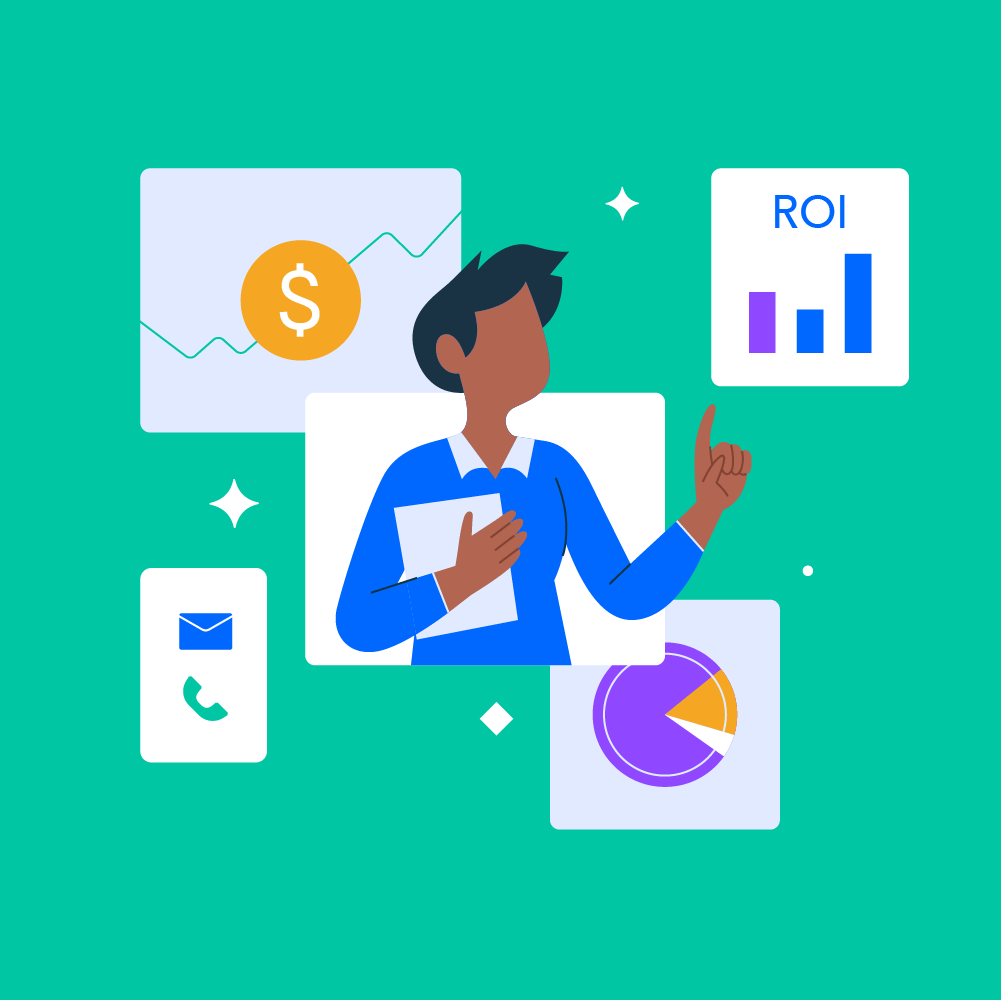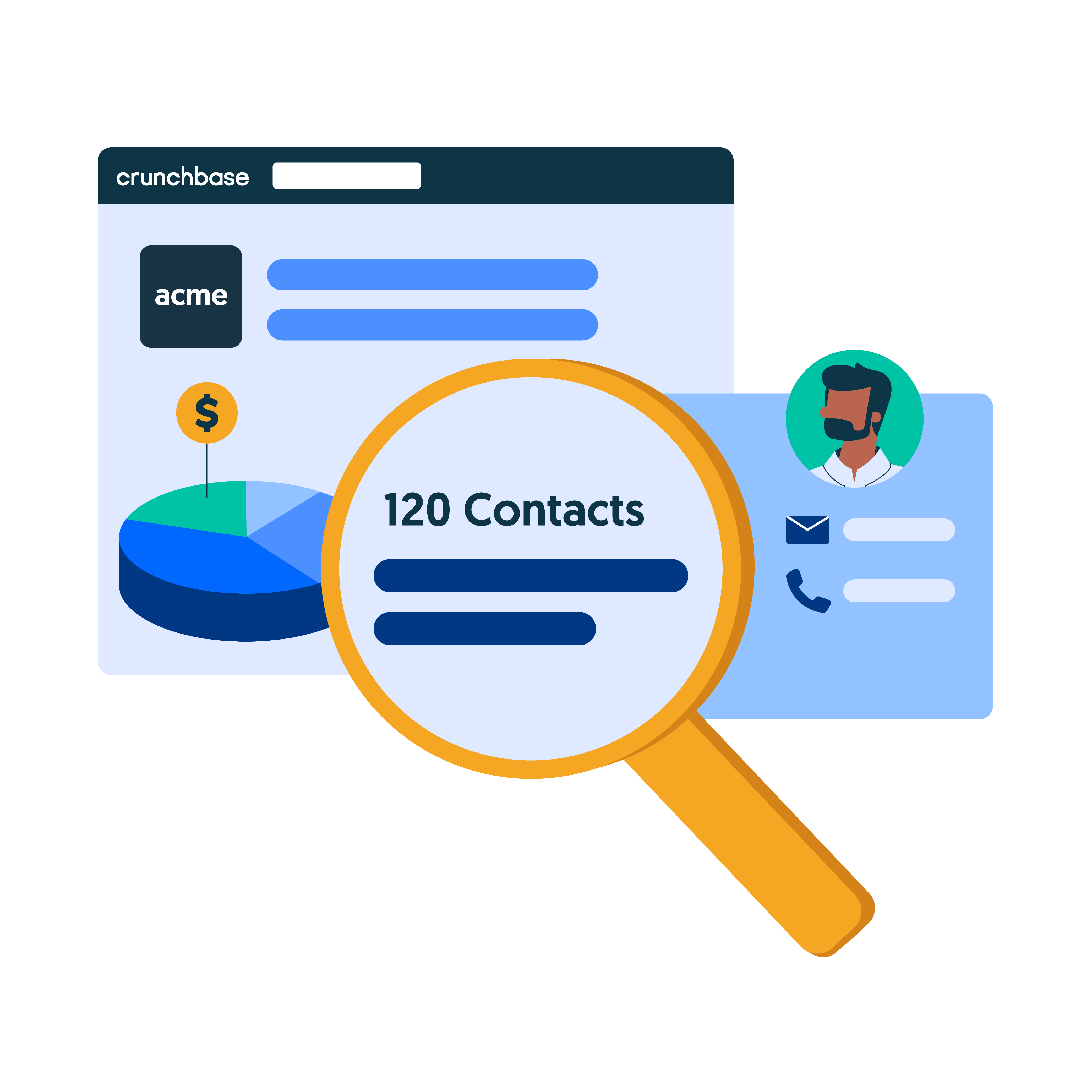Lead generation is what drives growth for businesses around the world.
But, let’s be honest. Lead generation is pointless if it doesn’t result in a prospect and a conversion. Before we dive into how to drive conversions, let’s first unpack the difference between a lead and a prospect, and how to interact with them during the sales prospecting process.
Search less. Close more.
Grow your revenue with all-in-one prospecting solutions powered by the leader in private-company data.
What is a lead?
Let’s start by comparing a lead vs. prospect: How do they differ?
It’s all in the communication. Regardless of how much research you may have done on a lead or a lead’s company, a lead is defined by one-way communication. Essentially, you’ve already reached out to your lead, but they’ve yet to reply. Don’t fret—the first part of your sales funnel is always (and should be) the biggest, and most leads won’t become prospects.
Types of leads
There are several types of leads. While every company defines leads a bit differently, a few examples of leads include:
- People on your email list(s);
- New connections on LinkedIn;
- People who engage with you on social media (likes, comments, shares);
- People who’ve engaged with your website (blog posts, views/clicks on key conversion pages, etc.); and
- MQLs (leads qualified by your marketing team and passed on to the sales team).
What is a prospect?
Prospects are leads that have either engaged with you and indicated they are good candidates for outreach or qualified by your sales team as matching your ideal customer profile.
Qualifying leads as prospects and identifying which prospects are worth reaching out to is the second step in the sales funnel. The greatest dropoff in the sales funnel is generally this jump from leads to prospects, as qualification considers many factors, but most importantly the probability that a lead will eventually become a customer. A prospect, by engaging with your company, has indicated a level of interest; therefore, they are considered “qualified” as likely to become a new customer.
Types of prospects
Some examples of prospects include:
- A lead you spoke with over the phone.
- Someone who replied to an email.
- Someone who clicked a link in a message and visited your website.
- An individual you spoke to at a trade show.
- A stranger who asked about your product on social media.
Leads vs. prospects: Differences explained
Now that you know what a prospect and a lead are, let’s take a closer look at their differences. The distinction between prospects vs. leads is important to make because your approach to moving them down your sales funnel will be different. You need two separate strategies for each group.
A lead is always an unqualified contact; you’ve yet to establish a relationship with them. Prospects have likely already engaged with your marketing or sales team and have a high chance of graduating to a qualified sales opportunity.
Taken at face value, it may seem as if there’s little difference between the two, but each one requires a tailor-made strategy to generate a conversion.
How to turn a lead into a prospect
Turning a lead into a prospect is all about qualification. The qualification process takes place on three levels, making it more likely that someone will turn into a customer and ensures they are the right fit for your product or service.
When your lead becomes a prospect and responds positively to outreach, they become a qualified prospect.
Here’s what you need to know about the qualification of a lead from the perspective of a sales rep.
Organizational qualification
The initial stage of qualification takes place at the organizational level. Take your lead and compare them to your company’s buyer persona.
Let’s say your company specializes in online collaboration software for startups in the tech industry.
How would you ensure they meet the criteria of your company’s buyer persona?
Answer these questions:
- What industry is the company in?
- Where is it headquartered?
- How many employees does the company have?
- Does it have the financial means to afford your software (indicated by funding rounds, M&A activity, company size, etc.)?
- Does it need your software (is it already working with a competitor)?
Search less. Close more.
Find and qualify leads faster with Crunchbase, the all-in-one prospecting solution powered by leading private-company data.
Even if you approach a passionate, interested prospect, if you can’t make the case for how your solution will help their business’ bottom-line right now, you aren’t going to close the deal. Ultimately, they’ll fail this stage of the qualification process.
Opportunity qualification
The next stage of turning a lead into a prospect is assessing opportunity. The first question you need to ask is whether that lead’s business can feasibly implement your product. Then you need to ask if the business would benefit from using that product.
Showing a genuine interest in your prospect’s business is key to opportunity qualification. Not all contacts will be immediately forthcoming with the insights you need to qualify them, so it’s important to have a clear plan before you meet with a prospect and outline the information you need to obtain in each interaction. And, if you can’t provide a clear readout of benefits and an implementation plan, the chances of turning a lead into a customer are slim.
Stakeholder qualification
Once you’ve determined that your company is the right fit for a prospect, it’s time to ensure that they have the authority to make a purchasing decision.
While a sales team manager may fall in love with your product, chances are they’re not in charge of purchasing. With that in mind, an important prospecting tactic is to identify the correct stakeholder to close the deal. This is more of a problem when selling to larger companies with bigger, more intricate hierarchies.
What is a qualified sales opportunity?
Sales opportunities represent the next step in the sales funnel. Once you’ve completed the qualification process, you can confirm that your prospect is qualified.
A qualified sales opportunity has a relatively high chance of becoming a customer. They are now actively considering your solution. However, there are a few key characteristics that make up a qualified sales opportunity.
1. Pain Point
Products and services are designed to solve a particular pain point. Addressing a need is at the core of what makes a product or service successful. It’s the driving motivator for why people buy in the first place.
With a prospect vs. lead, you’ve likely already found the company’s pain point and then confirmed it when moving through the cycle from a prospect to a qualified prospect.
Sales reps are responsible for identifying pain points. Remember, the lead prospect may not express their pain points. Oftentimes, sales reps need to create rapport with a prospect to bring those pain points to the surface.
2. Interest
Other than the existing problems your solutions are designed to solve, there’s also the aspect of interest.
Just because someone has a problem doesn’t mean they’re willing to invest to solve it. A 20-year problem, for example, likely isn’t an issue for them, so why would they pay money to solve it?
This is why sales reps are advised to ask how long a prospect had the problem. Acute pain is more likely to result in a sale than long-term pain that’s faded into the background.
3. Fit
Assuming you’ve identified a potential customer with a defined pain point and a desire to solve the problem, you need to determine whether they’re a fit for your company.
If you primarily deal in tech solutions aimed at small startups with 50 employees or fewer, a prospect isn’t a good fit if they work for Amazon or Meta (formerly Facebook).
Successful customer relationships rely on products and services being aligned with the customer’s situation. While it might be tempting to make the sale anyway, a poor customer experience only leads to negative online reviews.
Tips for turning a lead into a sale
Qualification is a crucial step to make sure you’ve found the perfect match. But, the chances are you’ll need to do some convincing.
Sales opportunities may have a strong desire to buy, and they might be the right fit, but they’re referred to as “opportunities” for a reason. Sales reps still need to seal the deal and make the sale. Here are a few tips that can help you close more deals.
Dangle the ROI carrot
First and foremost, your prospects care about numbers. They want to see a return on their investment, and they want it quickly. By the time you’re ready to attempt to close the sale, you likely already know what your prospect wants to achieve.
When you engage your lead in conversation — whether it’s via email, over a call or even via social prospecting — give a ballpark figure for how much ROI they can expect from your solution.
Offer an incentive
Incentives are the oldest trick in the book. Regardless of whether you’re talking to a lead versus a prospect, offering a discount or a bonus increases your chances of securing the sale.
If the offer is time-limited, it can even create a sense of urgency. Successful sales are all about guiding your leads and prospects toward a “yes.”
The simplest incentive you can offer is a free trial for a few days or weeks. That way, your potential clients get acquainted with your solution and will likely be better equipped to advocate for the purchase of your solution internally.
Develop a great help guide
Whenever a business invests in a solution, there are sticking points. The longer it takes to get a sale, the greater chance you have of losing your opportunity entirely.
Start by developing a helpful guide full of the most common questions. FAQs can help provide a sales opportunity with all the information they need to make a decision.
Ask for the sale
Taking a direct approach and asking for the sale is sometimes seen as too presumptive. But sometimes, the simple act of asking the question will get a direct answer from an opportunity.
In the worst-case scenario, they say no, and you can either handle their objections or spend your time on people who are more likely to make a purchase.
Conclusion
Modern sales teams need to have a clear understanding of what differentiates leads and prospects. They also must have a defined strategy for crossing the line and upgrading leads to prospects and qualified prospects to opportunities.
The good news is, tools like Crunchbase can help you automate the most painful and time-consuming steps in the sales process. With automatic account recommendations, buy signal and company news alerts, and the ability to push prospects to Salesforce, Crunchbase is your one-stop-shop for finding and closing deals.
Learn more by checking out our all-in-one sales prospecting software to grow your revenue.







